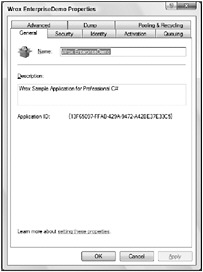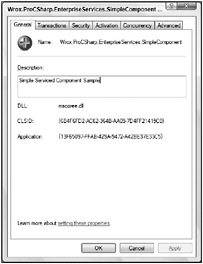Component Services Explorer
After a successful configuration, you can see Wrox EnterpriseDemo as an application name in the tree view of the Component Services Explorer. This name was set by the attribute [ApplicationName]. Selecting Action ![]() Properties opens the dialog box shown in Figure 38-4. Both the name and the description have been configured by using attributes. When you select the Activation tab, you can see that the application is configured as a server application because this has been defined with the [ApplicationActivation] attribute, and selecting the Security tab shows that the Enforce access checks for this application option is not selected because the attribute [ApplicationAccessControl] was set to false.
Properties opens the dialog box shown in Figure 38-4. Both the name and the description have been configured by using attributes. When you select the Activation tab, you can see that the application is configured as a server application because this has been defined with the [ApplicationActivation] attribute, and selecting the Security tab shows that the Enforce access checks for this application option is not selected because the attribute [ApplicationAccessControl] was set to false.

Figure 38-4
The following is a list of some more options that can be set with this application:
-
Security - With the security configuration, you can enable or disable access checks. If security is enabled, you can set access checks to the application level, the component, the interface, and to the method level. It is also possible to encrypt messages that are sent across the network using packet privacy as an authentication level for calls. Of course, this also increases the over-head.
-
Identity - With server applications, you can use the Identity tab to configure the user account that will be used for the process that hosts the application. By default, this is the interactive user. This setting is very useful while debugging the application but cannot be used on a production system if the application is running on a server, because there might not be anybody logged on. The configuration can be changed for a specific user.
-
Activation - The Activation tab allows you to configure the application either as a library or as a server application. Two new options with COM+ 1.5 are the option to run the application as a Windows Service and to use SOAP to access the application. Windows Services are discussed in Chapter 22, “Windows Services.” Selecting the SOAP option uses .NET Remoting configured within Internet Information Server to access the component. .NET Remoting is discussed in Chapter 37, “.NET Remoting.”
With an application proxy, the option Remote server name is the only option that can be configured. This option sets the name of the server. By default, the DCOM protocol is used as the network protocol. However, if SOAP is selected in the server configuration, the communication happens through .NET Remoting.
-
Queuing - The Queuing configuration is required for service components that make use of message queuing.
-
Advanced - On the Advanced tab, you can specify whether the application should be shut down after a certain period of client inactivity. You can also specify whether to lock a certain configuration so that no one can change it accidentally.
-
Dump - If the application crashes, you can specify the directory where the dumps should be stored. This is useful for components developed with C++.
-
Pooling & Recycling - Pooling and recycling is a new option with COM+ 1.5. With this option, you can configure whether the application should be restarted (recycled) depending on application lifetime, memory needs, number of calls, and so on.
With the Component Services Explorer, you can also view and configure the component itself. When opening child elements of the application, you can view the component Wrox.ProCSharp.EnterpriseServices.SimpleComponent. Selecting Action ![]() Properties opens the dialog box shown in Figure 38-5.
Properties opens the dialog box shown in Figure 38-5.

Figure 38-5
Using this dialog box, you can configure these options:
-
Transactions - On the Transactions tab, you can specify whether the component requires transactions. You use this feature in the next example.
-
Security - If security is enabled for the application, with this configuration you can define what roles are allowed to use the component.
-
Activation - The Activation configuration enables you to set object pooling and to assign a construction string.
-
Concurrency - If the component is not thread-safe, concurrency can be set to Required or Requires New. This way the COM+ runtime only allows one thread at a time to access the component.